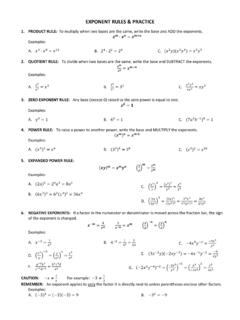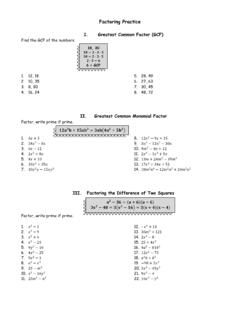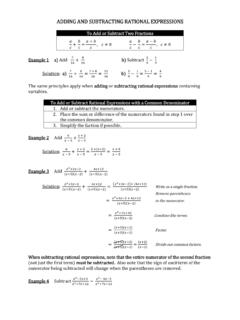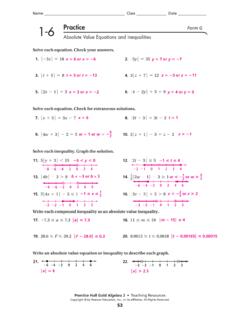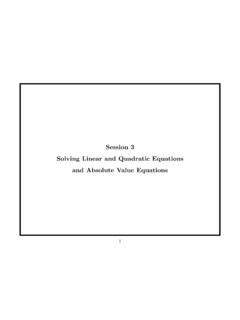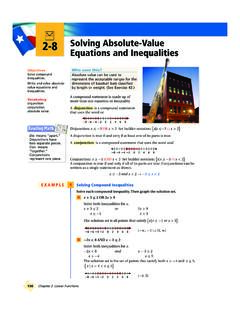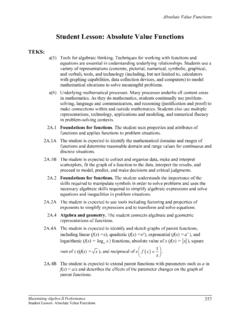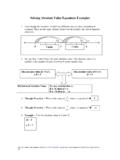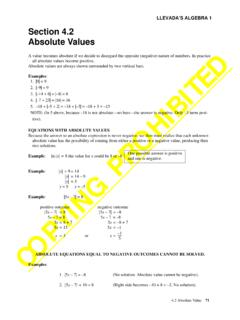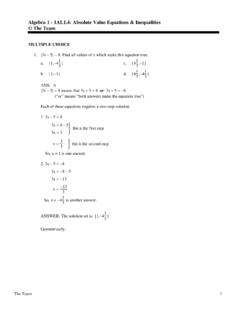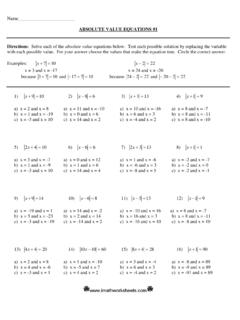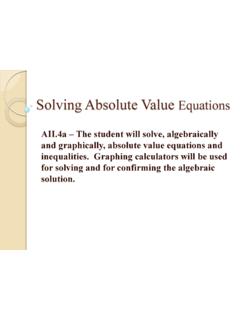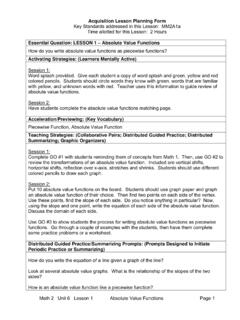Transcription of Solving Absolute Value Equations and Inequalities
1 1 Absolute Value Equations and Inequalities Absolute Value Definition - The Absolute Value of x, is defined = , 0 , < 0 where x is called the argument Steps for Solving Linear Absolute Value Equations : + = 1. Isolate the Absolute Value . 2. Identify what the isolated Absolute Value is set equal a. If the Absolute Value is set equal to zero, remove Absolute Value symbols & solve the equation to get one solution. b. If the Absolute Value is set equal to a negative number, there is no solution. c. If the Absolute Value is set equal to a positive number, set the argument (expression within the Absolute Value ) equal to the number and set it equal to the opposite of the number, using an or statement in between the two Equations . Then solve each equation separately to get two solutions. Examples: a. 3 +12 +7 = 7 b. 3 7 +7 = 2 c. 3 7 +7 = 9 3 +12 = 0 3 7 = 5 3 7 = 2 Because this equals Because this equals Because this equals 0, there is ONE solution.
2 A negative number, a positive number there is NO solution. there are TWO sltns. 3 +12 = 0 No Solution 3 7 = 2 or 3 7 = 2 3 = 12 3 = 9 or 3 = 5 = = or = d. +5 = 2 1 Set up two Equations +5 = +(2 1) or +5 = (2 1) = or +5 = 2 +1 3 = 4 = - 2 Steps for Solving Linear Absolute Value Inequalities : .# + 1. Isolate the Absolute Value . 2. Identify what the Absolute Value inequality is set equal a. If the Absolute Value is less than zero, there is no solution. b. If the Absolute Value is less than or equal to zero, there is one solution. Just set the argument equal to zero and solve. c. If the Absolute Value is greater than or equal to zero, the solution is all real numbers. d. If the Absolute Value is greater than zero, the solution is all real numbers except for the Value which makes it equal to zero.
3 This will be written as a union. e. If the Absolute Value is less than or less than or equal to a negative number, there is no solution. The Absolute Value of something will never be less than or equal to a negative number. f. If the Absolute Value is greater than or greater than or equal to a negative number, the solution is all real numbers. The Absolute Value of something will always be greater than a negative number. g. If the Absolute Value is less than or less than or equal to a positive number, the problem can be approached two ways. Either way, the solution will be written as an intersection. i. Place the argument in a 3-part inequality (compound) between the opposite of the number and the number, then solve. ii. Set the argument less than the number and greater than the opposite of the number using an and statement in between the two Inequalities . h. If the Absolute Value is greater than or greater than or equal to a positive number, set the argument less than the opposite of the number and greater than the number using an or statement in between the two Inequalities .
4 Then solve each inequality, writing the solution as a union of the two solutions. 3. Graph the answer on a number line and write the answer in interval notation. Examples: a. 4 0 b. 2 1 +4 < 4 c. 3+ +1 3 2 1 <0 +1 0 All Real Numbers No Solution Set +1 = 0 So = % 3 d. 3 +4 +5 3 e. 2 1 4 2 f. 6 +6 4 3 +4 2 2 1 6 6 10 No Solution 1 3 All Real Numbers 1 3 '( 1 3 4 '( 2 ( , *+ - , ) g. 2 <8 h. 3 4 1 9 i. +6 >0 4 1 3 Set +6 0 So 6 2 < 8 '( 2 > 8 ( , ) ( , ) < 6 '( > 10 > 6 '( < 10 ( ,%1) Option 1 Split in to two different Option 2 Write as a compound Inequalities joined by an AND inequality (Intersection) statement (Intersection) 3 4 1 9 3 4 1 9 4 1 3 4 1 3 3 4 1 3 (add 1) 4 1 3 234 4 1 3 2 4 4 (divide by 4) 1 234 56 56 1 7 %* ,%+ 7 %* ,%+ Problem h can be solved using two different approaches.)))))
5 4 Steps for Solving NON- Linear Absolute Value Equations : Follow the same steps as outlined for the linear Absolute Value Equations , but all answers must be plugged back in to the original equation to verify whether they are valid or not ( Check your answers. ) Occasionally, extraneous solutions can be introduced that are not correct and they must be excluded from the final answer. Examples: a. 6+1 = 5 Check your answers! 2 Equations Check: = 2 Check: = 2 6+1 = 5 or 6+1 = 5 (2)6+1 = 5 ( 2)6+1 = 5 x6= 4 or 6= 6 5 = 5 5 = 5 9 6= 94 or 9 6= 9 6 5 = 5 5 = 5 = * or = ; < = >?! = * Works! = * Works! b. 6+5 +4 = 0 Check your answers! Only 1 Equation Check: = 1 Check: = 4 6+5 +4 = 0 ( 1)6+5( 1)+4 = 0 ( 4)6+5( 4)+4 = 0 ( +1)( +4)= 0 1 5+4 = 0 16 20+4 = 0 +1 = 0 and +4 = 0 0 = 0 0 = 0 0 = 0 0 = 0 = % and = = % Works!
6 = Works! c. +3 = 6 4 3 Check your answers! 2 Equations Plugging each of the 4 answers into original +3 = 6 4 3 or +3 = ( 6 4 3) equation results in .. 6 5 6 = 0 or +3 = 6+4 +3 = 1 2 = 2 ( 6)( +1)= 0 or 6 3 = 0 = 6 9 = 9 6 = 0 and +1 = 0 or ( 3)= 0 = 0 3 3 = and = % or = 1 and = = 3 6 6 So, the only answers to the problem are = % and = . ( = 0 =A = 3 are extraneous). 5 Absolute Value Practice Problems Problem Answer Type 1. = 8 B 8,8C Equation, + number 2. 2 = 6 B 4,8C Equation, + number 3. +1 = 0 B 1 C Equation, zero 4. 4 = 6 No Solution Equation, - number 5.
7 3 +2 = 10 B 4,DEF Equation, + number 6. 2 +5 +4 = 3 No Solution Equation, - number 7. 2 4 1 = 6 G 56,1C Equation, + number 8. 5H 2 6 +1 = 2 B1,5C Equation, + number 9. 3 1 6 = 3 No Solution Equation, - number 10. 7 +2 = 2 B 7 C Equation, zero 11. 3 +2 = 6 B 4,1C Equation, = 12. 4 = 4 Equation, = 13. 2 - 2 ,2+ Inequality, + nmbr 14. +3 > 4 ( , 7) ( 7 , ) Inequality, + nmbr 15. +3 < 6 No Solution Inequality, - nmbr 6 16. 3 2 4 9 Inequality, - nmbr 17. 2 9 +6 > 6 ( , 9) (9 , ) Inequality, zero 18. 4 3 1 8 No Solution Inequality, - nmbr 19. 5 2 +2 3 3 B 1 C Inequality, zero 20. 10+ 56 4 10 Inequality, zero 21. 3J56 +2J+6 < 15 ( 10 ,2) Inequality, + nmbr 22.
8 6 4 = 4 No Solution Equation, Non-Linear 23. 6+9 +14 = 0 = 2, 7 Equation, Non-Linear 24. 6+1 = 2 = 1 Equation, Non-Linear 25. 1 = 6+4 5 = 6, 1 Equation, Non-Linear





